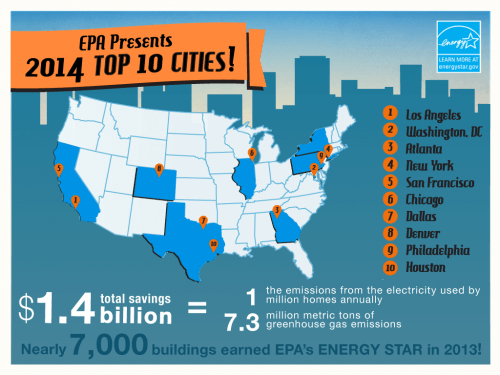EPA Announces Cities With the Most ENERGY STAR Buildings; Seven of Top 15 Are in City Energy Project
Today, the U.S. Environmental Protection Agency (EPA) announced the 2014 list of top cities with the most ENERGY STAR-certified buildings. Seven out of the top 15 cities are participants in the City Energy Project, a joint initiative by IMT and the Natural Resources Defense Council to ramp up building efficiency in major cities around the United States.
These and other American cities are seeing the important role that their buildings can play in reducing greenhouse gas emissions. IMT congratulates them on lowering energy bills and reducing harmful pollution by tackling the problem of energy waste.

The top cities, along with the count of 2013 ENERGY STAR buildings in each:
1 Los Angeles 443 City Energy Project
2 Washington, DC 435
3 Atlanta 318 City Energy Project
4 New York 303
5 San Francisco 289
6 Chicago 233 City Energy Project
7 Dallas-Fort Worth 229
8 Denver 221 City Energy Project
9 Philadelphia 210 City Energy Project
10 Houston 204 City Energy Project
11 Charlotte 176
12 Phoenix 156
13 Boston 141 City Energy Project
14 Seattle 127
15 San Diego 123
16 Minneapolis 116
17 Sacramento 109
18 Miami 101
19 Cincinnati 84
20 San Jose, Calif. 83
21 Columbus, Ohio 77
22 Riverside, Calif. 75
23 Detroit, Mich. 73
24 Portland, Ore. 71
25 Louisville, Ky. 60
In most cities, commercial buildings are the largest source of carbon emissions. Chicago, for example, estimates that the energy used by buildings accounts for 70 percent of the city’s carbon emissions. In New York City, that figure jumps to nearly 80 percent.
To date, more than 23,000 buildings across America have earned EPA’s ENERGY STAR. These buildings have saved more than $3.1 billion on utility bills and prevented greenhouse gas emissions equal to the annual electricity use from 2.2 million homes.
Commercial buildings that earn EPA’s ENERGY STAR must perform in the top 25 percent of similar buildings nationwide and must be independently verified by a licensed professional engineer or a registered architect. ENERGY STAR certified buildings use an average of 35 percent less energy and are responsible for 35 percent less carbon emissions than typical buildings. Many types of commercial buildings can earn the ENERGY STAR, including office buildings, K-12 schools, hotels, and retail stores.
More on this year’s top cities: www.energystar.gov/topcities
More on ENERGY STAR certified buildings: www.energystar.gov/buildinglist
More about earning the ENERGY STAR label for commercial buildings: www.energystar.gov/labeledbuildings